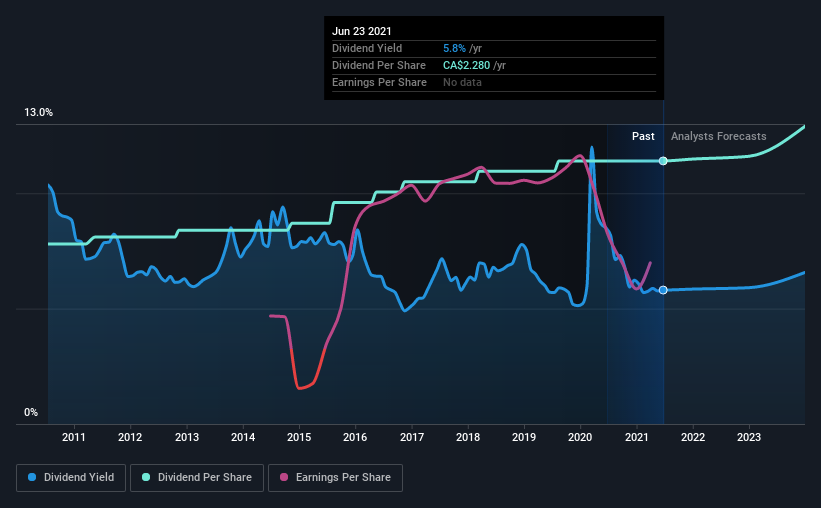Don't Race Out To Buy Exchange Income Corporation (TSE:EIF) Just Because It's Going Ex-Dividend

Regular readers will know that we love our dividends at Simply Wall St, which is why it's exciting to see Exchange Income Corporation (TSE:EIF) is about to trade ex-dividend in the next four days. Typically, the ex-dividend date is one business day before the record date which is the date on which a company determines the shareholders eligible to receive a dividend. The ex-dividend date is important as the process of settlement involves two full business days. So if you miss that date, you would not show up on the company's books on the record date. Accordingly, Exchange Income investors that purchase the stock on or after the 29th of June will not receive the dividend, which will be paid on the 15th of July.
The company's next dividend payment will be CA$0.19 per share, on the back of last year when the company paid a total of CA$2.28 to shareholders. Looking at the last 12 months of distributions, Exchange Income has a trailing yield of approximately 5.8% on its current stock price of CA$39.28. Dividends are a major contributor to investment returns for long term holders, but only if the dividend continues to be paid. So we need to investigate whether Exchange Income can afford its dividend, and if the dividend could grow.
Check out our latest analysis for Exchange Income
Dividends are typically paid out of company income, so if a company pays out more than it earned, its dividend is usually at a higher risk of being cut. Exchange Income distributed an unsustainably high 199% of its profit as dividends to shareholders last year. Without more sustainable payment behaviour, the dividend looks precarious. A useful secondary check can be to evaluate whether Exchange Income generated enough free cash flow to afford its dividend. Over the last year it paid out 61% of its free cash flow as dividends, within the usual range for most companies.
It's good to see that while Exchange Income's dividends were not covered by profits, at least they are affordable from a cash perspective. If executives were to continue paying more in dividends than the company reported in profits, we'd view this as a warning sign. Extraordinarily few companies are capable of persistently paying a dividend that is greater than their profits.
Click here to see the company's payout ratio, plus analyst estimates of its future dividends.

Have Earnings And Dividends Been Growing?
Businesses with shrinking earnings are tricky from a dividend perspective. Investors love dividends, so if earnings fall and the dividend is reduced, expect a stock to be sold off heavily at the same time. With that in mind, we're discomforted by Exchange Income's 6.8% per annum decline in earnings in the past five years. Such a sharp decline casts doubt on the future sustainability of the dividend.
Many investors will assess a company's dividend performance by evaluating how much the dividend payments have changed over time. In the last 10 years, Exchange Income has lifted its dividend by approximately 3.9% a year on average. That's intriguing, but the combination of growing dividends despite declining earnings can typically only be achieved by paying out a larger percentage of profits. Exchange Income is already paying out 199% of its profits, and with shrinking earnings we think it's unlikely that this dividend will grow quickly in the future.
The Bottom Line
Is Exchange Income an attractive dividend stock, or better left on the shelf? Earnings per share have been in decline, which is not encouraging. Worse, Exchange Income's paying out a majority of its earnings and more than half its free cash flow. Positive cash flows are good news but it's not a good combination. Overall it doesn't look like the most suitable dividend stock for a long-term buy and hold investor.
So if you're still interested in Exchange Income despite it's poor dividend qualities, you should be well informed on some of the risks facing this stock. Our analysis shows 4 warning signs for Exchange Income that we strongly recommend you have a look at before investing in the company.
If you're in the market for dividend stocks, we recommend checking our list of top dividend stocks with a greater than 2% yield and an upcoming dividend.
When trading stocks or any other investment, use the platform considered by many to be the Professional's Gateway to the Worlds Market, Interactive Brokers. You get the lowest-cost* trading on stocks, options, futures, forex, bonds and funds worldwide from a single integrated account. Promoted
Valuation is complex, but we're here to simplify it.
Discover if Exchange Income might be undervalued or overvalued with our detailed analysis, featuring fair value estimates, potential risks, dividends, insider trades, and its financial condition.
Access Free AnalysisThis article by Simply Wall St is general in nature. It does not constitute a recommendation to buy or sell any stock, and does not take account of your objectives, or your financial situation. We aim to bring you long-term focused analysis driven by fundamental data. Note that our analysis may not factor in the latest price-sensitive company announcements or qualitative material. Simply Wall St has no position in any stocks mentioned.
*Interactive Brokers Rated Lowest Cost Broker by StockBrokers.com Annual Online Review 2020
Have feedback on this article? Concerned about the content? Get in touch with us directly. Alternatively, email editorial-team (at) simplywallst.com.
About TSX:EIF
Exchange Income
Engages in aerospace and aviation services and equipment, and manufacturing businesses worldwide.
Reasonable growth potential and fair value.
Market Insights
Community Narratives



